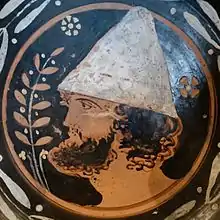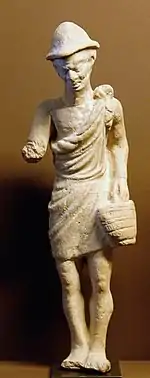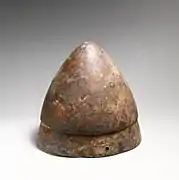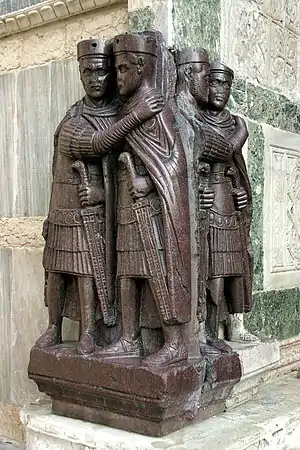
The pileus (Ancient Greek: πῖλος, pîlos; also pilleus or pilleum in Latin) was a brimless felt cap worn in Ancient Greece, Etruria, Illyria (especially Pannonia),[1][2][3][4] later also introduced in Ancient Rome.[5] The pileus also appears on Apulian red-figure pottery.
The pilos together with the petasos were the most common types of hats in Archaic and Classical era (8th–4th century BC) Greece.[6] In the 5th century BC, a bronze version began to appear in Ancient Greece and it became a popular infantry helmet. It occasionally had a horsehair crest.[7] The Greek pilos resembled the Roman and Etruscan pileus, which were typically made of felt.[8] The Greek πιλίδιον (pilidion) and Latin pilleolus were smaller versions, similar to a skullcap.
Similar caps were worn in later antiquity and the early medieval ages in various parts of Europe, as seen in Gallic and Frankish dress.[8] The Albanian traditional felt cap, the plis, worn today in Albania, Kosovo and adjacent areas, originated from a similar felt cap worn by the ancient Illyrians.
A pointed version called pileus cornutus served as a distinguishing sign for the Jewish people in the Holy Roman Empire for five centuries (12th–17th centuries).[9]
Name
The word for the cap in antiquity was pil(l)eus or pilos, indicating a kind of felt.[10] Greek πῖλος pilos, Latin pellis, Albanian plis, as well as Old High German filiz and Proto-Slavic *pьlstь are considered to come from a common Proto-Indo-European root meaning "felt".[11]
History

Ancient Greece
Pilos hat
The pilos (Greek: πῖλος, felt[12]) was a typical conical hat in Ancient Greece among travelers, workmen and sailors, though sometimes a low, broad-rimmed version was also preferred, known as petasos.[13] It could be made of felt or leather. The pilos together with the petasos were the most common types of hats in Archaic and Classical era (8th–4th century B.C.) Greece.[6]
Pilos caps often identify the mythical twins, or Dioscuri, Castor and Pollux, as represented in sculptures, bas-reliefs and on ancient ceramics. Their caps were supposedly the remnants of the egg from which they hatched.[14] The pilos appears on votive figurines of boys at the sanctuary of the Cabeiri at Thebes, the Cabeirion.[15]
In warfare, the pilos type helmet was often worn by the peltast light infantry, in conjunction with the exomis, but it was also worn by the heavy infantry.
In various artistic depictions in the middle Byzantine period soldiers are seen wearing pilos caps.[16]
Pilos helmet
From the 5th century B.C the Greeks developed the pilos helmet which derived from the hat of the same name.[17] This helmet was made of bronze in the same shape as the pilos which was presumably sometimes worn under the helmet for comfort, giving rise to the helmet's conical shape.[18] Some historians theorize that the pilos helmet had widespread adoption in some Greek cities such as Sparta,[19][4] however, there is no primary historical source or any archeological evidence that would suggest that Sparta or any other Greek state would have used the helmet in a standardized fashion for their armies. What led historians to believe that the helmet was widespread in places such as Sparta was, amongst other reasons, the supposed advancement of battlefield tactics that required that infantry have full vision and mobility.[19] However, many other types of Greek helmet offered similar designs to the pilos when it came to visibility, such as the konos or the chalcidian helmets.
Etruria
Being of Greek origin the Pilos helmet was worn in the late Etruscan Period by the local armies in the region.[20]
Illyria
A so-called "Illyrian cap" was also known as "Panonian pileus" in the period of the Tetrarchy.[1] As such during the period of the Emperor-soldiers the influences of the Illyrian provinces of the Roman Empire were evident, such as the wide use of the Pannonian pileus.[3]
The Albanian traditional felt cap (Albanian: plis, cognate of pilos[11] and pileus) originated from a similar felt cap worn by the Illyrians.[21][22] The 1542 Latin dictionary De re vestiaria libellus, ex Bayfio excerptus equated an Albanian hat with a kyrbasia, and described it as a "tall pileus [hat] in the shape of a cone" (pileus altus in speciem coni eductus).[23]
An Illyrian wearing a pileus has been hesitantly identified on a Roman frieze from Tilurium in Dalmatia; the monument could be part of a trophy base erected by the Romans after the Great Illyrian Revolt (6–9 BCE).[24]
A cylindrical flat-topped felt cap made of fur or leather originated in Pannonia, and came to be known as the Pannonian cap (pileus pannonicus).[25][10][26][3][1]
Rome

The Roman pileus resembled the Greek pilos and was often made of felt.[8] In Ancient Rome, a slave was freed in a ceremony in which a praetor touched the slave with a rod called a vindicta and pronounced him to be free. The slave's head was shaved and a pileus was placed upon it. Both the vindicta and the cap were considered symbols of Libertas, the goddess representing liberty.[27] This was a form of extra-legal manumission (the manumissio minus justa) considered less legally sound than manumission in a court of law.
One 19th-century dictionary of classical antiquity states that, "Among the Romans the cap of felt was the emblem of liberty. When a slave obtained his freedom he had his head shaved, and wore instead of his hair an undyed pileus."[28] Hence the phrase servos ad pileum vocare is a summons to liberty, by which slaves were frequently called upon to take up arms with a promise of liberty (Liv. XXIV.32). The figure of Liberty on some of the coins of Antoninus Pius, struck A.D. 145, holds this cap in the right hand.[29]
In the period of the Tetrarchy, the Pannonian cap (pileus pannonicus) was adopted as the main military cap of the Roman army, until the 6th century AD; it was worn by lightly armed or off-duty soldiers, as well as workmen.[2][3][10] It often appears in Roman artwork, in particular mosaics, from the late 3rd century AD. The earliest preserved specimen of the hat was found at the Roman quarry of Mons Claudianus, in the eastern desert of Egypt, and is dated to 100–120 AD; it has a dark-green color, and looks like a low fez or pillbox hat.[10][30]
Later periods and variants
Similar caps were worn in later antiquity and the early medieval ages in various parts of Europe, as seen in Gallic and Frankish dress, in particular of the Merovingian and Carolingian era.[8]
Gallery
 Ancient Greek pilos type helmet, 450–425 BC
Ancient Greek pilos type helmet, 450–425 BC Odysseus wearing the pilos. Ancient Greek red-figure situla from Apulia, ca. 360 BC, Museo Nazionale Archaeologico, Naples
Odysseus wearing the pilos. Ancient Greek red-figure situla from Apulia, ca. 360 BC, Museo Nazionale Archaeologico, Naples

 The pileus particularly identifies the Dioscuri (here on a colossal statue of late Antiquity in the Campidoglio, Rome).
The pileus particularly identifies the Dioscuri (here on a colossal statue of late Antiquity in the Campidoglio, Rome). John Wilkes depicted by Hogarth with the cap of Liberty on a pole, as it was sometimes carried in public demonstrations during the 18th century
John Wilkes depicted by Hogarth with the cap of Liberty on a pole, as it was sometimes carried in public demonstrations during the 18th century Ancient Greek helmets. Top line, from left to right: Illyrian type helmet, Corinthian helmet. Bottom line, from left to right: Phrygian type helmet, Pileus helmet with an olive branch ornament, Chalcidian helmet. Staatliche Antikensammlungen
Ancient Greek helmets. Top line, from left to right: Illyrian type helmet, Corinthian helmet. Bottom line, from left to right: Phrygian type helmet, Pileus helmet with an olive branch ornament, Chalcidian helmet. Staatliche Antikensammlungen
 Part of a Roman mosaic depicting Odysseus at Skyros unveiling the disguised Achilles,[31] from La Olmeda, Pedrosa de la Vega, Spain, 5th century AD
Part of a Roman mosaic depicting Odysseus at Skyros unveiling the disguised Achilles,[31] from La Olmeda, Pedrosa de la Vega, Spain, 5th century AD The Tetrarchs, a porphyry statue on Venice's Basilica di San Marco, shows the emperor Diocletian and his three imperial colleagues. All wear the woollen "Pannonian" pileus caps worn by officers in the late army.
The Tetrarchs, a porphyry statue on Venice's Basilica di San Marco, shows the emperor Diocletian and his three imperial colleagues. All wear the woollen "Pannonian" pileus caps worn by officers in the late army.
See also
References
Citations
- 1 2 3 Wagner, Hendrik (2021). Das spätantike Rom und die stadtrömische Senatsaristokratie (395–455 n. Chr.): Eine althistorisch-archäologische Untersuchung. Walter de Gruyter GmbH & Co KG. p. 375. ISBN 9783110727630.
Zu erkennen an der „illyrischen Kappe", dem sog. pileus Pannonicus, bekannt u. a. von der bekannten Tetrarchengruppen in Venedig und dem Ambulatio-Mosaik von Piazza Armerina. Auch auf den Sarkophagen tragen die Soldaten, die Petrus Oder Paulus in Haft nehmen, diese Kopfbedeckung (z. B. lunius-Bassus-Sarkophag).
- 1 2 Cleland, Liza; Davies, Glenys; Llewellyn-Jones, Lloyd (2007). Greek and Roman Dress from A to Z. Routledge. p. 88. ISBN 978-0-203-93880-5.
Pannonia and Illyria also appear to have been especially associated with hats. Plautus (...) lampoons an Illyrian hat so big the wearer looks like a mushroom. The pilleus Pannonicus, a pill-box hat adopted from Pannonia by Roman soldiers in the late third century AD, came to be worn almost exclusively by the late imperial military.
- 1 2 3 4 Rocco, Marco (2012). L'esercito romano tardoantico: persistenze e cesure dai Severi a Teodosio I. Studi e progetti: scienze umanistiche. Libreria Universitaria. p. 557. ISBN 9788862922302.
Soprattutto durante il periodo degli imperatori-soldati prevalgono nettamente gli influssi delle province illiriche, che si esplicano nell'ampia diffusione del pilleus pannonico, delle ring-buckle belts e della tunica a maniche lunghe chiamata dalmatica.
- 1 2 Campbell, Duncan B. (2012). Spartan Warrior 735–331 BC. Bloomsbury Publishing. p. 34. ISBN 978-1849087018.
- ↑ "pileus", Encyclopædia Britannica
- 1 2 Lee, Mireille M. (12 January 2015). Body, Dress, and Identity in Ancient Greece. Cambridge University Press. p. 160. ISBN 978-1-107-05536-0.
The pilos... periods.
- ↑ Ober, Jesse (2012). "A Brief History of Greek Helmets". AncientPlanet Online Journal. 2: 15. Retrieved 1 August 2019.
- 1 2 3 4 Yarwood, Doreen (1 January 2011). Illustrated Encyclopedia of World Costume. Courier Corporation. p. 65. ISBN 978-0-486-43380-6.
The Greek pilos... Carolingian dress.
- ↑ LUBRICH, NAOMI (2015). "The Wandering Hat: Iterations of the Medieval Jewish Pointed Cap". Jewish History. 29 (3/4): 203–244. doi:10.1007/s10835-015-9250-5. ISSN 0334-701X. JSTOR 24709777. S2CID 159821873. Retrieved 6 May 2022.
- 1 2 3 4 Summer, Graham; D'Amato, Raffaele (2009). Arms and Armour of the Imperial Roman Soldier. Frontline Books. p. 218. ISBN 978-1-84832-512-8.
- 1 2 Vladimir Orel (1998). Albanian Etymological Dictionary. Brill Academic Pub. p. 334. ISBN 9004110240.
- ↑ πῖλος, Henry George Liddell, Robert Scott, A Greek-English Lexicon, on Perseus
- ↑ Sacks, David; Murray, Oswyn (1995). A Dictionary of the Ancient Greek World. Oxford University Press. p. 62. ISBN 9780195112061.
"Travelers, workmen, and sailors might wear a conical cap known as a pilos; travelers, hunters, and other sometimes wore the low, broad-rimmed hit (petasos)
- ↑ John Tzetzes, On Lycophron, noted by Karl Kerenyi's The Heroes of the Greeks, 1959:107 note 584.
- ↑ Walter Burkert. Greek Religion, 1985:281.
- ↑ Diamanti, Charikleia; Vassiliou, Anastasia (19 December 2019). En Sofía mathitéfsantes: Essays in Byzantine Material Culture and Society in Honour of Sophia Kalopissi-Verti. Archaeopress Publishing Ltd. p. 229. ISBN 978-1-78969-263-1.
Most of them... πίλος.
- ↑ Everson, Tim (18 November 2004). Warfare in Ancient Greece: Arms and Armour From the Heroes of Homer to Alexander the Great. The History Press. p. 55. ISBN 978-0-7524-9506-4.
the Greeks also developed the Pilos, Boeotian and Thracian helmets, which soon supplanted the former in popularity. The Pilos helmet derived from a felt cap called the Pilos.
- ↑ Nick Sekunda,The Spartan Army, p.30
- 1 2 Jesse Obert, A Brief History of Greek Helmets, p.16
- ↑ D’Amato, Raffaele; Salimbeti, Andrea (20 September 2018). The Etruscans: 9th–2nd Centuries BC. Bloomsbury Publishing. p. 50. ISBN 978-1-4728-2832-3.
The pilos helmet, of Greek origin, ...
- ↑ Stipčević, Aleksandar (1977). The Illyrians: History and Culture. History and Culture Series. Noyes Press. p. 89. ISBN 0815550529.
It is generally agreed, and rightly so, that the modern Albanian cap originates directly from the similar cap worn by the Illyrians, the forefathers of the Albanians.
- ↑ Qosja, Rexhep (1982). Recherches albanologiques: Folklore et ethnologie. Instituti Albanologijik i Prishtinës. p. 52. Retrieved 14 April 2013.
Ne kuadrin e veshjeve me përkime ilire, të dokumentuara gjer më tani hyjnë tirqit, plisi, qeleshja e bardhë gjysmësferike, goxhufi-gëzofi etj.
- ↑ Bernis, Carmen (1969). "Échanges pendant la Renaissance entre les modes espagnoles et les modes de l'Europe centrale et orientale (hongroise, albanaise et turque)". In Rósza, György (ed.). Actes du XXIIe Congrés International d'Histoire de l'Art, Budapest, 1969: Évolution générale et développements régionaux en histoire de l'art (in French). Vol. 1. Akadémiai Kiadó (published 1972). p. 706.
Le dictionnaire latin BAYFIO. «De re vestiaria», publié à Paris en 1542, constitue un témoignage intéressant du fait que les occidentaux consideraient le chapeau albanais comme un chapeau haut. Ce dictionnaire décrit la «cibaria» [kyrbasia] comme un chapeau albanais ou comme un «pileus altus in speciem coni eductus».
- ↑ Polito, Eugenio (1998). Fulgentibus armis: introduzione allo studio dei fregi d'armi antichi (in Italian). L'ERMA di BRETSCHNEIDER. pp. 61, 155–156. ISBN 9788870629927.
- ↑ Schrenk, Sabine (2006). Textiles in Situ: Their Find Spots in Egypt and Neighbouring Countries in the First Millenium CE. Abegg-Stiftung. p. 154. ISBN 978-3-905014-29-7.
- ↑ Cooper, Stephen Andrew (2005). Marius Victorinus' Commentary on Galatians. Oxford University Press. p. 74. ISBN 978-0-19-152077-8.
- ↑ Cobb, T.R.R. (1858). An inquiry into the law of Negro slavery in the United States of America. Philadelphia: T. & J.W. Johnson. p. 285, 285n2.
- ↑ πίλεον λευκόν, Diodorus Siculus Exc. Leg. 22 p. 625, ed. Wess.; Plaut. Amphit. I.1.306; Persius, V.82
- ↑ Yates, James. Entry "Pileus" in William Smith's A Dictionary of Greek and Roman Antiquities (John Murray, London, 1875).
- ↑ Bender Jørgensen, Lise (2018). "Textiles from Mons Claudianus, 'Abu Sha'ar and other Roman Sites in the Eastern Desert.". In Brun, Jean-Pierre; Faucher, Thomas; Redon, Bérangère (eds.). The Eastern Desert of Egypt during the Greco-Roman Period: Archaeological Reports. Collège de France. ISBN 9782722604889.
- ↑ Documentation on the "Villa romana de Olmeda", displaying a photograph of the whole mosaic, entitled "Aquiles en el gineceo de Licomedes" (Achilles in Lycomedes' 'seraglio').
Bibliography
- Sumner, Graham (2003). Roman Military clothing (2) AD 200 to 400. ISBN 978-1841765594.
Further reading
- Sekunda, Nicholas and Hook, Adam (2000). Greek Hoplite 480–323 BC. Osprey Publishing. ISBN 1-85532-867-4
External links
- Institute of France – Greek Costume (PDF in French)
- Antiquitas – Casque corinthien et pilos
- A Brief History of Greek Helmets by Jesse Obert – AncientPlanet Online Journal Vol. 2 (2012), 48 – 59
- Chisholm, Hugh, ed. (1911). . Encyclopædia Britannica. Vol. 3 (11th ed.). Cambridge University Press. p. 980. "similar to the pileus or pileolus (skull-cap)"
